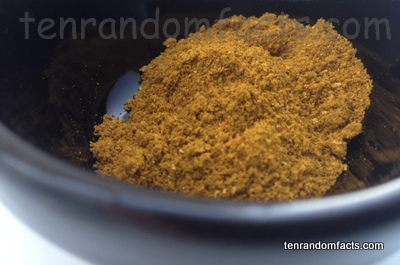Do not let the curry powder burn your mouth… or these facts burn your brain.
- Curry powder is a preparation of spices used primarily in dishes to add flavour and a pleasant smell.
- Curry powder is made primarily of spices, most often turmeric, cumin and coriander, but the mixture also often contains chilli and fenugreek, and sometimes garlic and ginger.
- Curry powder typically produces both a flavour and a curry similar to foods from Asia’s south and it is often spicy.
- Curry powder is often used in curry sauces, but also dishes that require a distinct flavour, and the mixture can be homemade or commonly available in supermarkets or Asian grocery stores.
- Curry powder most likely arrived in European society in 1771, and an advertisement for the product appeared in a British newspaper, dated 1784.
- Curry powder became common in the 1800s and 1900s after the introduction of machines that can mass produce, as well as becoming a widespread and popular export.
- Curry powder became increasingly popular in 1960s to 1970s with the demand and supply of Indian cuisine.
- Curry powder is typically coloured yellow, orange, red, grey or brown, depending on the spice mix, and the powder particles are often very fine, but vary in size.
- Commercially bought curry powder often loses its prominent taste and strength after lengthy storage times, and usually starts deteriorating from six months.
- Curry powder is high in fibre, vitamin E, vitamin K, iron and manganese, and is said to help protect against inflammation and cancer.
Bibliography:
Breslin F, Currying Flavor, 2012, Cook for Your Life, http://www.cookforyourlife.org/ingredients/90-curry-powder
Curry Powder, 2014, Wikipedia, http://en.wikipedia.org/wiki/Curry_powder
History of Spice and Curry Powder, n.d, Vijay, http://www.vijaymasala.com/?page_id=364
Kelley L, The Origins of Curry Powder, 2013, Silk Road Gourmet, http://www.silkroadgourmet.com/curry-powder/







